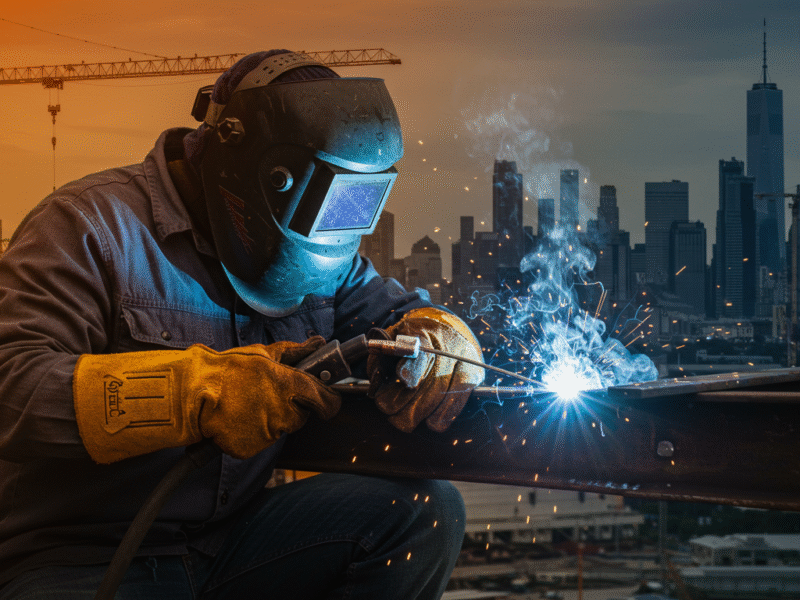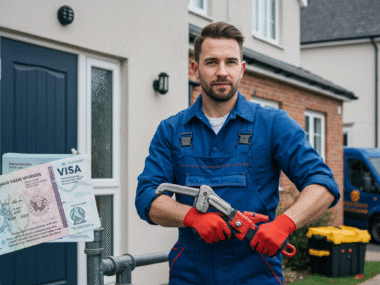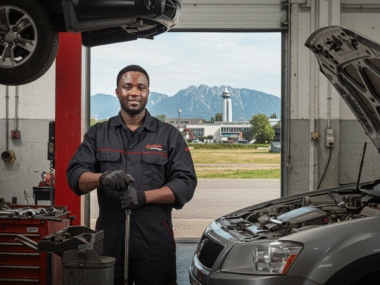Imagine sparking your career into high gear, literally, by landing a hands-on welding job in the heart of America’s booming construction scene, complete with a visa that opens doors to new horizons. That’s the exciting reality for skilled welders eyeing opportunities in the USA this year. As we dive into 2025, the construction industry is hotter than a fresh weld bead, with massive infrastructure projects, urban developments, and energy builds creating a surge in demand for talented welders. If you’re an international worker dreaming of steady paychecks, career growth, and the American lifestyle, construction welding jobs with visa sponsorship could be your ticket. This guide breaks it all down in simple terms—from what these jobs entail, to how to snag one, salaries, top spots, and real tips to make it happen. Let’s get welding!
What Are Construction Welding Jobs?
The Role of a Construction Welder
Construction welding jobs in the USA are far from average backyard fixes; they’re the backbone of building everything from skyscrapers in New York to bridges in California. Welders in construction join metal parts using heat and precision tools, ensuring structures are safe and durable. You might work on steel beams for high-rises, pipelines for oil rigs, or custom fabrications for stadiums.
Day-to-Day Responsibilities
These jobs involve physical work, such as climbing scaffolds, operating MIG or TIG welders, and collaborating with engineers and builders. In 2025, with the government’s push for infrastructure renewal under acts like the Bipartisan Infrastructure Law, there’s no shortage of projects. Welders often read blueprints, prep materials, and inspect welds to meet strict safety codes like those from the American Welding Society (AWS).
Why It’s Rewarding
If you love problem-solving and hands-on creativity, this field lets you build landmarks that last generations. It’s challenging but rewarding, offering a sense of accomplishment with every completed project.
Why the USA Is a Hot Spot for Welders in 2025
The Construction Boom
The USA is in the middle of a construction boom, driven by aging roads, new green energy farms, and expanding cities. Welders are essential for structural integrity in everything from residential builds to massive commercial sites.
Industry Demand and Growth
According to labor stats, the demand for welders, cutters, solderers, and brazers is projected to grow steadily, with thousands of openings each year due to retirements and industry expansion. In construction specifically, welders are key, with over 400,000 welding-related jobs in the USA, including 50,000+ in structural and pipeline welding.
Perks and Benefits
The USA offers competitive perks like health insurance, retirement plans, and overtime pay that can boost earnings. For international workers, visa sponsorship makes these opportunities accessible, as companies actively seek skilled talent from abroad due to a shortage of certified welders domestically.
The Role of Technology
In 2025, with economic recovery post-pandemic and new tech like automated welding, the field is evolving, but human expertise remains irreplaceable.
Understanding the Demand for Welders
By the Numbers
The Bureau of Labor Statistics reports that employment for welders is expected to hold strong, with construction being one of the top sectors. Sites like Indeed and ZipRecruiter list hundreds of construction welding jobs with sponsorship, from entry-level fabricators to specialized pipe welders.
Key Industries Driving Demand
Projects like high-speed rail in Texas or renewable energy hubs in the Midwest are fueling employer demand. The push for sustainable building means more work in eco-friendly materials, and welders certified in advanced techniques like flux-cored arc welding are in high demand.
Navigating Visa Sponsorship for Welders
What Is Visa Sponsorship?
Visa sponsorship means a US employer agrees to support your work visa application, covering paperwork and proving they need your skills. For welders, this is feasible because welding is a skilled trade with proven shortages. In 2025, sponsorship is more common in construction due to labor needs.
The Application Process
The process starts with a job offer, followed by the company filing petitions with USCIS. It’s not instant—expect 3-6 months—but worth it for long-term stability. Many welders start on temporary visas and transition to permanent ones.
Key Tip for Success
Build a strong resume highlighting certifications and experience to stand out. A clean background check and proof of skills are essential.
Types of Visas for Construction Welders
H-2B Visa: Temporary Work
The H-2B visa is popular for temporary non-agricultural work, ideal for seasonal or project-based construction jobs. It’s capped at 66,000 per year, but welders qualify if the job is short-term, with employers proving temporary need.
EB-3 Visa: Path to Permanent Residency
The EB-3 visa is suited for skilled workers and requires labor certification showing no US applicants are available. It’s great for long-haul careers, leading to a green card.
Other Visa Options
Options like the H-1B for specialized roles (less common for trades) or the TN visa for Canadians/Mexicans under USMCA are also available. In 2025, policy tweaks may speed up EB-3 processing. Always check USCIS for updates.
Job Requirements for Construction Welders
Education and Training
A high school diploma plus vocational training or an apprenticeship in welding is typically required. Certifications like AWS D1.1 for structural welding are must-haves.
Experience and Skills
You’ll need 1-5 years of experience in construction welding, with skills in MIG, TIG, or stick welding. Physical fitness is key, as is passing tests for lifting, climbing, and working in tough conditions.
Additional Requirements
English proficiency helps, though not always required. Tech savvy, like knowing robotic welding, gives an edge in 2025. Employers also value reliability, safety records, and teamwork.
How to Find and Apply for Welding Jobs
Online Job Search
Start with platforms like Indeed (397 visa sponsorship welding jobs) and ZipRecruiter (908 welder US visa sponsorship openings). Search terms like “construction welder visa sponsorship USA 2025” yield results.
Networking and Applications
LinkedIn is great for networking—follow companies and join welder groups. Job boards like Jooble or Glassdoor have sponsorship filters. Tailor your application, highlighting international certifications, and prepare for virtual interviews.
Working with Agencies
Use agencies specializing in skilled trades immigration to streamline the process. Once offered a job, the employer handles visa petitions.
Top Companies Hiring Welders
Major Players
Big construction firms like Bechtel and Fluor often sponsor for mega-projects. Caterpillar seeks welders for equipment, sometimes with visas. Shipbuilding firms like Huntington Ingalls and general contractors like Turner Construction list openings.
Other Employers
Energy firms like Black & Veatch hire pipe welders, while smaller fabrication outfits like JR Metal Works also sponsor. Check career pages for sponsorship details.
Best Locations for Welding Jobs
Top States
Texas leads with 48,380 welders, thanks to oil and construction booms. California follows with 31,510, driven by urban builds. Alaska offers the highest pay at $79,210, followed by Hawaii ($75,590) and Wyoming ($65,730).
Emerging Hotspots
Illinois, New Jersey, and Tennessee have high demand due to infrastructure and auto industries. Ohio, Wisconsin, and North Dakota are also strong for pipeline and manufacturing work.
Salary Expectations for Construction Welders
Average Earnings
The average hourly wage for construction welders is $29.79, or about $62,000 yearly. Entry-level welders earn $35,000-$50,000, while experienced welders make $60,000-$75,000. The median is $51,000, per BLS.
Additional Benefits
Sponsored jobs often include health coverage, 401(k), overtime (up to $45/hour), and relocation help. In high-cost states, bonuses are common.
Essential Skills and Certifications
Core Skills
Master arc welding, blueprint reading, and safety protocols. AWS certifications like D1.1 for structures are critical.
Advanced Skills
Skills in robotic or underwater welding give a competitive edge. Soft skills like teamwork and attention to detail are also valued.
Training Opportunities
Programs from institutions like Lincoln Tech can boost your qualifications and job prospects.
Challenges and Tips for Success
Common Challenges
Visa processing waits, competition, and cultural adjustments can be hurdles.
Practical Tips
Get certified early, improve English skills, and network on forums. Save for initial relocation costs to ease the transition.
Real Success Stories
Inspiring Examples
A Nigerian welder landed an H-2B visa with a Texas firm, now earning $60,000 after sponsorship. An Indian welder secured an EB-3 visa via a pipeline job, building a stable family life in the USA. These stories show persistence pays.
Conclusion: Your Path to a Welding Career in the USA
Construction welding jobs in the USA with visa sponsorship in 2025 offer a solid path to success. With high demand, competitive salaries, and opportunities across the country, it’s time to ignite your future. Start searching today!
Additional Resources
For more information, check these resources











